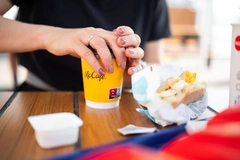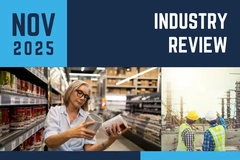
- Industry news
Industry news
- Category news
- Reports
- Key trends
- Multimedia
Multimedia
- Journal
- Events
- Suppliers
Suppliers
- Home
- Industry news
Industry news
- Category news
- Reports
- Key trends
- Multimedia
Multimedia
- Events
- Suppliers
Suppliers
Packaging and labels prioritized amid market and inflation challenges, new RRD report finds

Packaging companies are adjusting their designs in response to rising inflation and market pressures, reveals a newly published report by R.R. Donnelley & Sons Company (RRD), the US-based global provider of marketing, packaging, print and supply chain solutions. We discuss the report’s findings and implications with RRD’s president for for packaging, labels and supply chain segment, Lisa Pruett, and packaging solutions president, Brian Techter.
In September, RRD surveyed 300 US-based decision-making business representatives who highlighted product safety and functional design as top priorities for packaging. They identified packaging and labels as important to meeting sustainability goals and consumers’ expectations and adapting to the pressure of e-commerce growth. The report also finds that supply chain complexities and material sourcing require further attention.
“Inflation and material costs are driving brands to rethink packaging and labels to better meet consumer demands. Eighty-nine percent of packaging respondents said they expect to make design changes — with 36% reporting anticipating major changes — to enhance functionality and adapt to evolving consumer expectations,” Pruett and Techter tell Packaging Insights.
“That might seem counter-intuitive because cost-sensitivity looms large. Survey respondents also cited material price increases (72%), supply chain shortages (67%) and supplier reliability issues (64%) as factors influencing the changes they make in packaging and labeling. However, by listening and responding to consumer needs, these companies can use this as an opportunity to connect differently with end users.”
Safety and functionality
Discussing how companies balance cost constraints with maintaining or improving safety and functionality, Pruett and Techter say that these aspects of packaging are “paramount and cannot be compromised.”
 Lisa Pruett, RRD president for labels and supply chain segment.“To support product integrity, the majority of packaging respondents are utilizing specialized packaging materials for added protection (64%) and focusing on end-user feedback (58%). By addressing these pressures for optimal cost efficiency, companies are better positioned to maintain quality and strengthen customer trust.”
Lisa Pruett, RRD president for labels and supply chain segment.“To support product integrity, the majority of packaging respondents are utilizing specialized packaging materials for added protection (64%) and focusing on end-user feedback (58%). By addressing these pressures for optimal cost efficiency, companies are better positioned to maintain quality and strengthen customer trust.”
The experts say that in practice, companies are applying user feedback, utilizing specialized packaging materials for added protection, investing in packaging testing and strengthening partnerships with logistics providers.
“Our clients have turned to us for advice and guidance in navigating their packaging decisions, but we see most success with clients who are flexible and open to change when it comes to packaging design, development and sourcing alternative materials.”
“Consumers have been demanding greater transparency on sustainability and product safety for years. We see our customers prioritizing coherent messaging and packaging that safely protects the product inside while helping brands work toward sustainability targets of using fewer, more environmentally-friendly materials,” say Pruett and Techter.
Meeting sustainability goals
Companies are conscious of material recycling and waste elimination, state Pruett and Techter. “The key is just in that — being aware of the different methods that complement each other in the effort to offset environmental impact.”
“While reduction of material waste is the leading tactic identified by 69% of respondents, material recycling is a close second (68%), followed by lightweighting (54%) and inclusion of recycled materials (52%).”
They say that different companies are taking action in different ways. “For instance, by rightsizing their packaging to ensure more efficient transportation. To see progress, it is crucial to support a circular economy, a model of production and consumption that leans on sharing, reusing, and recycling existing materials for as long as possible.”
The RRD report further outlines sustainable aesthetics in packaging as an emerging trend. “Sustainable aesthetics encapsulate the three packaging priorities of protection, convenience and brand appeal, while educating consumers on environmental impact.”
“We’ve seen brands redesign packaging with soft colors and inks, foils and materials that can all be recycled, along with exterior messaging to convey those benefits, such as recycling labels and instructions.”
“Also, brands have been using kraft substrates to highlight the eco-friendly feeling and messaging. Through our survey, we see 57% of respondents are planning to focus on sustainable aesthetics in the next two years, so it’s increasingly becoming a priority.”
E-commerce growth
The RRD experts note that companies are innovating in packaging or labeling to tailor them specifically for the expanding e-commerce space.
.jpg) Brian Techter, RRD packaging solutions president.“We see how companies are actively optimizing packaging for online sales and designing solutions to strengthen their e-commerce presence in a competitive marketplace. More than half of respondents who have seen e-commerce growth (55%) have designed packaging to specifically address their online presence.”
Brian Techter, RRD packaging solutions president.“We see how companies are actively optimizing packaging for online sales and designing solutions to strengthen their e-commerce presence in a competitive marketplace. More than half of respondents who have seen e-commerce growth (55%) have designed packaging to specifically address their online presence.”
“Through this alternative to the in-person shopping experience, packaging takes on multiple roles of not only protecting the product and delivering it safely and with less waste (not a box in another box) but also communicating brand values and deepening brand loyalty.”
Pruett and Techter say that every box or label is a touchpoint that brings the brand experience into consumers’ homes.
“Supply chain challenges are prompting companies to build more resilience into their operations, especially as they relate to diversifying and consolidating suppliers, as well as strengthening existing relationships with them,” they continue.
“The majority of label respondents (54%) diversified suppliers to deal with supply chain issues, inflation and other market pressures, and the most successful brands are those that can pivot quickly amid market changes or disruptions and remain forward-looking.”
They expect packaging and label operations to be impacted by AI in the future, with potential changes to design and development, production and manufacturing, supply chain, sustainability and the overall consumer experience.
“This encourages companies to assess their operations and identify areas for improvement in the future,” Pruett and Techter conclude.











